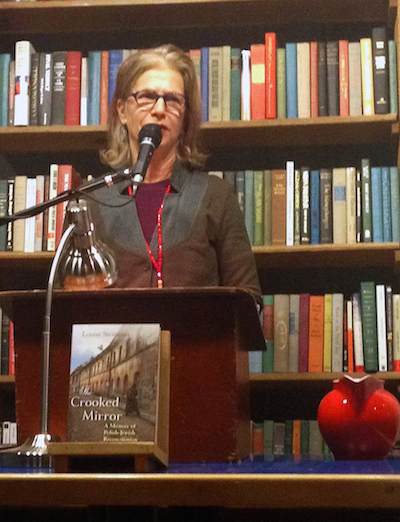By Deborah Gardner, Special to The Jewish Sound

When Louise Steinman first faced the suggestion of writing about Poles and Jews, she was unequivocal: No. Growing up Jewish with a mother whose parents had immigrated from Poland in 1906, she inherited what she calls “received prejudices” about Poland.
“I had no intention of setting foot in Poland or pursuing the topic,” she says.
But Steinman also knows there is truth to the cliché that writers don’t choose their stories; their stories choose them.
Her story began with an invitation from Rabbi Don Singer, leader of an informal Jewish congregation near Los Angeles that incorporates teachings from Zen Buddhism. He served as rabbi for an annual interfaith retreat to Auschwitz-Birkenau, at which participants bear witness and meditate together. He invited Steinman to join them.
“You would have to be out of your mind to do that,” Steinman thought.
Like some other American Jews of Polish descent — a population that comprises about 80 percent of American Jews — she felt no interest in reconciliation. But she became curious.
From early years working in theatre performance in Seattle, Steinman understands the power of art and experience to heal. She accepted Singer’s invitation and began to research.
She was surprised to find online a yizkor, or memory, book, from Radomsk, the town of her mother’s ancestors. These books, works of collective memory gathering written after the Holocaust, served as records of Jewish communities that had just been destroyed. Many are being translated into English from the Yiddish.
Steinman delighted in the details about her ancestral town, whose lively Jewish community co-existed with Polish Catholics and where, she writes, “a Polish Catholic painted the synagogue’s blue ceiling and a Jewish tinsmith roofed the spires of the Catholic church.”
The yizkor book pleaded: “Please! Descendants of Radomsk, wherever you are in the world; teach your children and grandchildren about our town and its people.”
“Surely they’re not talking to me,” Steinman said. “I’m a secular Jew. I go to Friday night services in a Zen center. I don’t keep kosher.” But this, she realized, is who many descendants are.
The interfaith gathering at Auschwitz-Birkenau was intensely powerful. It became the first of her nine trips to Poland over the course of a decade. Her new book, “The Crooked Mirror: A Memoir of Polish-Jewish Reconciliation,” published last month by Beacon Press, is a personal memoir of these geographic journeys and her own personal journey within Polish-Jewish reconciliation. She spoke about the book and shared slides from her trips on Dec. 3 at Seattle’s Elliott Bay Book Company.
The book’s title, like many Jewish anecdotes, has more than one meaning. A Polish priest, Józef Tischner, wrote: “When reflected in a crooked mirror, the face of a neighbor is distorted.” But Steinman also discovered there had been a satiric section of the Yiddish newspaper in Radomsk called Der Krumer Spiegel, The Crooked Mirror.
Steinman describes writing the book as an act of repairing the world. The book takes the reader along on that personal journey of serendipity, grief, disappointments, and connections.
Drawing on the Talmud’s statement that “a dream which is not interpreted is like a letter which is not read,” Steinman’s book is rich with descriptions of dreams as means of sorting out emotions of a journey.
Her story has resonated with people trying to connect or reconcile with their pasts, fill gaps in family history, or examine received prejudices. At the University of Southern California, several African American students related to the challenge of connecting with a past with a truncated ancestry. One student, working on a memoir, asked Steinman, “What do I do about all the gaps in the story?”
“You have to use them,” Steinman replied. Gaps and ruptures, she said, make us who we are.
Ruptures, she notes, have shaped the history of many American Jews. Almost every American Jew lost family in the Holocaust; we just may not know who they were. While her generation grew up with the maxim “Never forget,” the next step, she says, is remembering what existed before the trauma.
Her past had always felt full of nameless relatives her mother just called “the ones who didn’t get out of Poland.” Steinman found names and a great-aunt’s former house. But finding them was bittersweet.
“To gain people,” she said, “is also to lose them again.”
Rather than the generation that suffered the trauma, she says, reconciliation belongs to the next generation. But “reconciliation isn’t necessarily about forgiveness. It’s about looking at history together.”
Steinman tells of people in Poland willing to look together at the past, even the shameful past. She has become close with some of these people, and is tickled to realize that she now has friends living in Radomsko, modern-day Radomsk.
Some of her Polish friends are working on historical-memory art projects themselves, resonating with Steinman’s theater performance days. Art, she said, can help to make an absence palpable when other tangible remnants of history have been destroyed. She showed a photo of one installation: Beams of light rising from manholes in all that remained of a city’s Jewish quarter, the basements of houses long paved over.
For young Poles, there is also a sense of reclamation. Under Communism, it was taboo to talk about the fate of the Jews. When people went looking for an authentic Poland in the history of Poland’s Jews, it was a rebellious act. Times have changed: September 2014 brings the exhibition opening at Warsaw’s new Museum of the History of Polish Jews, dedicated to the hundreds of years of history of Jews in Poland.
“There’s no way to bring back the past,” Steinman says. But she believes in making symbolic gestures that resonate. Having put aside her own crooked mirror, she now hopes her book will be translated into Polish. There is interest already.
